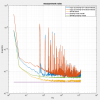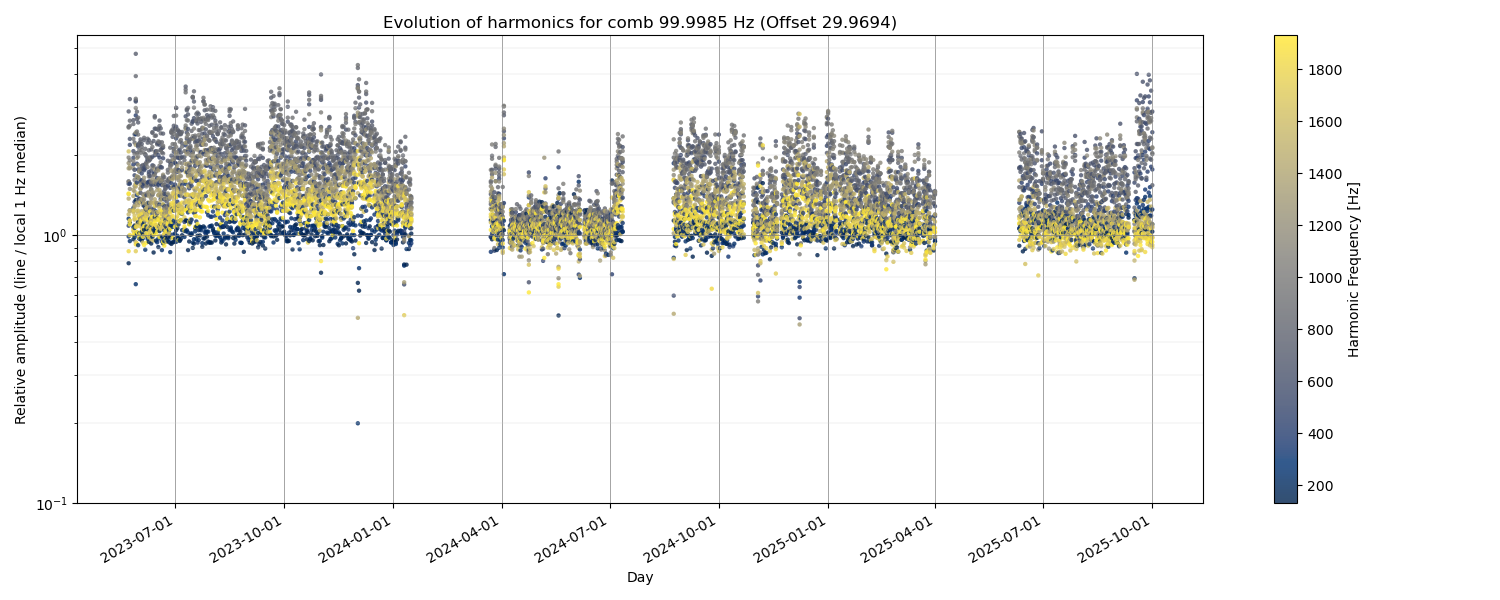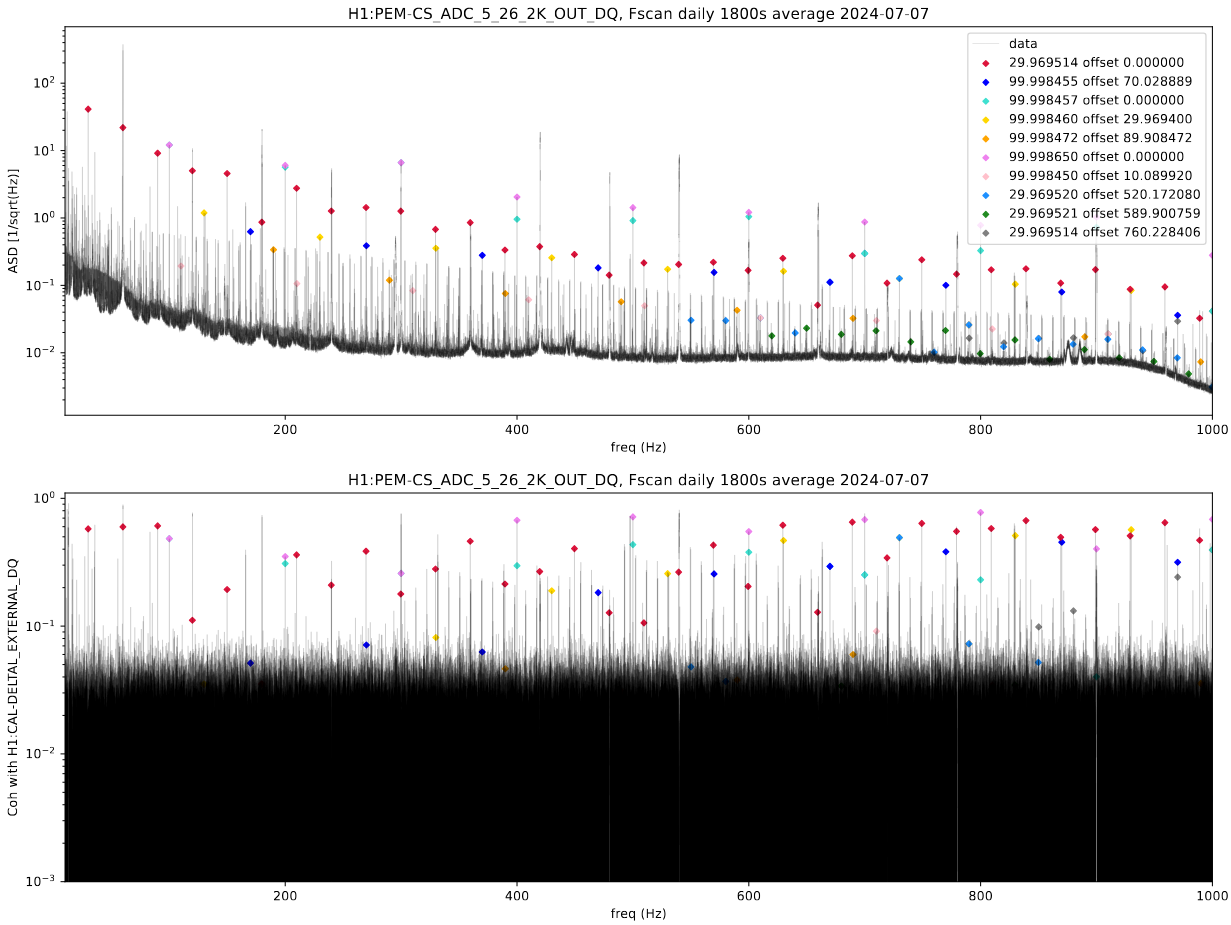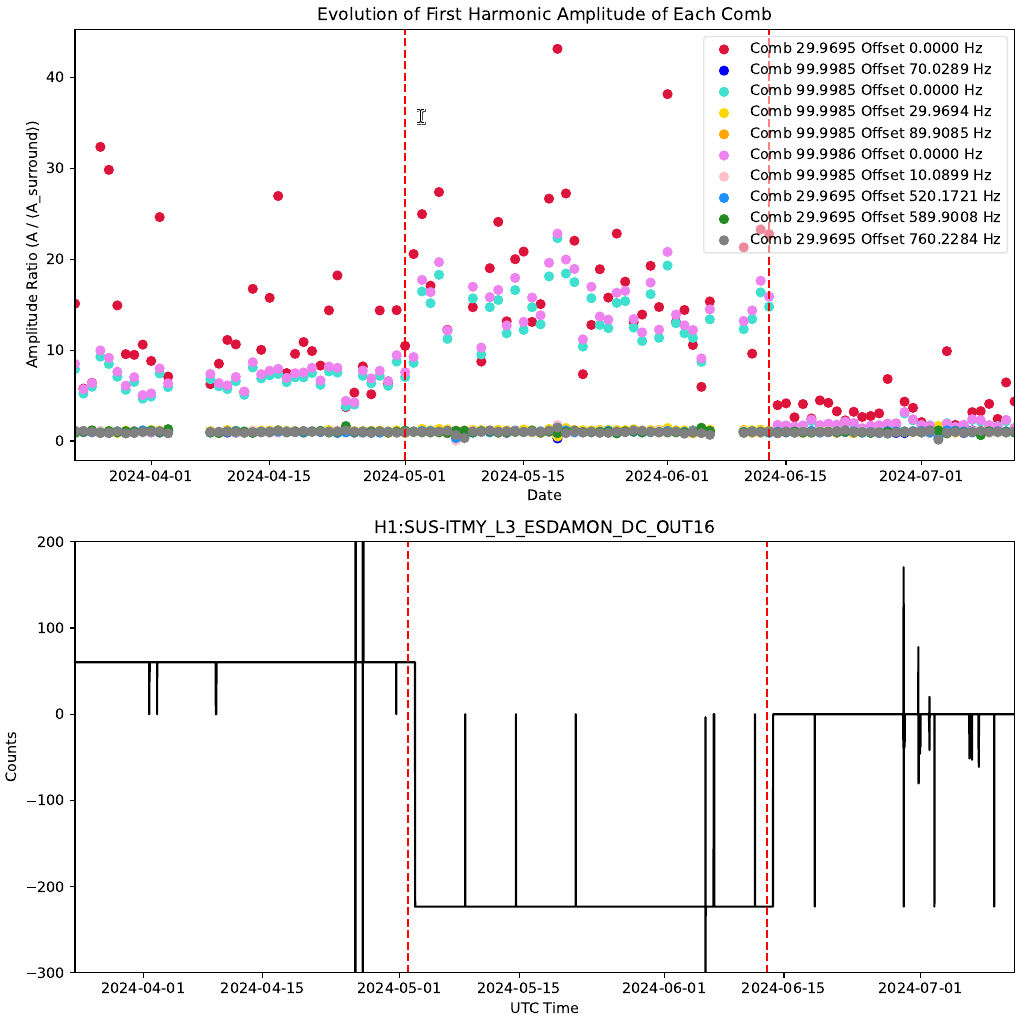Summary:
As "the last test before installation" I compared the dark noise level for all 8 PDs. Unfortunately the first PD in our own convention (top left when seen from the back, see this picture for PD number convention in the lab though it's probably different in the chamber) showed much larger noise level than all the others. See the first attachment left. (In this plot, PD 5 and 6 look noisier too, but this was found to be the preamp channels themselves.)
I swapped the entire PD assembly module (D1300130) for the noisy PD with the unit pulled from an incomplete spare ISS array assy originally removed from LLO HAM2 (S1202966) and measured the noise again. I also connected PD5 and 6 to the preamp channels for PD7 and 8 to remeasure the noise. Now no PD shows extra noise, see the right panel of the first attachment.
Note: Even though the plot title says "dark noise", the measurement is limited by the preamp noise and SR785 input noise (black trace). But this at least tells us that no PD is extra noisy. FYI the shot noise level for 10mA current is ~5.7e-11A/sqrtHz.
I checked the grounding of new PD1 unit (after temporarily disconnecting the SMP cables) and no shortcircuit was found.
I roughly aligned the newly installed PD1 but haven't done finer adjustment yet.
After PD1 position is finely adjusted, we'll have to repeat the jitter coupling measurement.
Measurement Details:
All 8PDs were originally connected to two obsolete 4-channel transimpedance amplifier chassis (D1300639-v1) because they were available while spares for the latest ones (D1600193) weren't found. In this alog the channels of the first unit (S1301390) CH1-CH4 and those of the second unit (S1301386) CH5-CH8.
The output of the transimpedance stage (TP2 in the 2nd screen shot) was connected to SR785, 2 channels at a time. (Just for comparison, the 3rd screen shot is the transimpedance stage for the latest one (D1600193) which is pretty similar to the obsolete one except for the opamp (0.9nV/sqrtHz AD797 in the obsolete one VS 2.2nV/sqrtHz@1k TLE2027).) I didn't use the whitening output as some of the channels of D1300639 weren't working (the output was railing).
Before swapping PD1, to make absolutely sure that the problem is PD not the preamp/SR785, I swapped the SMP-SMA cables for PD1 with those for PD2 at the back of the PD modules (i.e. PD1 goes to CH2 and PD2 to CH1) and the noise followed the PD.
The 4th attachment shows the noise level of the measurement. Red and blue traces were obtained by disconnecting two SMP-SMC cables from the preamp of CH1 and CH5.
CH1, 2, 3, 4, 7 and 8 were quite similar to each other, and CH6 was similar to CH5. In the end I had to swap cables for PD5 and PD6 to use CH7 and CH8.
"Preamp noise model" comprises the Johnson noise of 1.62k transimpedance, input voltage noise and input current noise of AD797 combined. I used typical 1kHz numbers here for AD797. The zero and the pole in the first stage are much higher than the measurement band here. Johnson noise of 10 Ohm (R7 in the second screenshot) in series with the PD won't matter in this measurement as well as when the PD is connected assuming that PD is a current source.
Other details:
The preamps are clearly labeled as D1300639-V2 (5th attachment), but the e-traveler for these boards (S1301390 and S1301386) say they're V1, and the actual board pattern (e.g. the first channel TIA opamp is U4, the transimpedance itself if R2 and the output of TIA opamp is connected to TP2 via R17, see the 7th screen shot) agrees with V1 (2nd screen shot) but not with V2 (6th screenshot).
I put "This is V1 not V2" label on both of the board. I also put "CH1 and CH2 noisy" label on S1301386.










 We list here the channels that do show most of these Combs. These same channels do show changes in coherence between July 1st and July 7th 2024, but do not show changes in the amplitude of the combs.
- H1_IMC-F_OUT_DQ
- H1_LSC-MCL_IN1_DQ
- H1_LSC-MICH_IN1_DQ
- H1_LSC-SRCL_IN1_DQ
- H1_PEM-CS_MAG_EBAY_LSCRACK_X_DQ
- H1_PEM-CS_MAG_EBAY_LSCRACK_Y_DQ
- H1_PEM-CS_MAG_EBAY_LSCRACK_Z_DQ
- H1_PEM-CS_MAG_LVEA_INPUTOPTICS_X_DQ
- H1_PEM-CS_MAG_LVEA_INPUTOPTICS_Y_DQ
- H1_PEM-CS_MAG_LVEA_INPUTOPTICS_Z_DQ
In most channels, the comb amplitude tends to get quite low after ~1500 Hz. The following sets of channels show differences between X, Y and Z:
- H1_PEM-CS_MAG_EBAY_SUSRACK_X_DQ (Higher amplitudes and towards higher frequencies)
- H1_PEM-CS_MAG_EBAY_SUSRACK_Y_DQ (Lower comb amplitudes)
- H1_PEM-CS_MAG_EBAY_SUSRACK_Y_DQ (Lower comb amplitudes)
Regarding CS_MAG_LVEA_OUTPUTOPTICS, these combs can be seen best in X, weaker in Y and almost non-existent in Z. (In CS_MAG_LVEA_INPUTOPTICS they look roughly the same height)
- H1_PEM-CS_MAG_LVEA_OUTPUTOPTICS_X_DQ (Strongest)
- H1_PEM-CS_MAG_LVEA_OUTPUTOPTICS_Y_DQ (Weaker lines)
- H1_PEM-CS_MAG_LVEA_OUTPUTOPTICS_Z_DQ (Almost no lines)
Same behavior at:
- H1_PEM-CS_MAG_LVEA_VERTEX_X_DQ (Strongest lines)
- H1_PEM-CS_MAG_LVEA_VERTEX_Y_DQ (Weaker lines)
- H1_PEM-CS_MAG_LVEA_VERTEX_Z_DQ (Almost no lines)
We can see that these combs mostly appear in the corner station. The combs do not appear in neither EX nor EY channels. However, comb 99.99865 Hz offset 0.000 appears in many EX, EY channels and does become more coherent after July 7th. However, it is very close to 100 Hz so it may be influenced by other round-number combs (?)
We list here the channels that do show most of these Combs. These same channels do show changes in coherence between July 1st and July 7th 2024, but do not show changes in the amplitude of the combs.
- H1_IMC-F_OUT_DQ
- H1_LSC-MCL_IN1_DQ
- H1_LSC-MICH_IN1_DQ
- H1_LSC-SRCL_IN1_DQ
- H1_PEM-CS_MAG_EBAY_LSCRACK_X_DQ
- H1_PEM-CS_MAG_EBAY_LSCRACK_Y_DQ
- H1_PEM-CS_MAG_EBAY_LSCRACK_Z_DQ
- H1_PEM-CS_MAG_LVEA_INPUTOPTICS_X_DQ
- H1_PEM-CS_MAG_LVEA_INPUTOPTICS_Y_DQ
- H1_PEM-CS_MAG_LVEA_INPUTOPTICS_Z_DQ
In most channels, the comb amplitude tends to get quite low after ~1500 Hz. The following sets of channels show differences between X, Y and Z:
- H1_PEM-CS_MAG_EBAY_SUSRACK_X_DQ (Higher amplitudes and towards higher frequencies)
- H1_PEM-CS_MAG_EBAY_SUSRACK_Y_DQ (Lower comb amplitudes)
- H1_PEM-CS_MAG_EBAY_SUSRACK_Y_DQ (Lower comb amplitudes)
Regarding CS_MAG_LVEA_OUTPUTOPTICS, these combs can be seen best in X, weaker in Y and almost non-existent in Z. (In CS_MAG_LVEA_INPUTOPTICS they look roughly the same height)
- H1_PEM-CS_MAG_LVEA_OUTPUTOPTICS_X_DQ (Strongest)
- H1_PEM-CS_MAG_LVEA_OUTPUTOPTICS_Y_DQ (Weaker lines)
- H1_PEM-CS_MAG_LVEA_OUTPUTOPTICS_Z_DQ (Almost no lines)
Same behavior at:
- H1_PEM-CS_MAG_LVEA_VERTEX_X_DQ (Strongest lines)
- H1_PEM-CS_MAG_LVEA_VERTEX_Y_DQ (Weaker lines)
- H1_PEM-CS_MAG_LVEA_VERTEX_Z_DQ (Almost no lines)
We can see that these combs mostly appear in the corner station. The combs do not appear in neither EX nor EY channels. However, comb 99.99865 Hz offset 0.000 appears in many EX, EY channels and does become more coherent after July 7th. However, it is very close to 100 Hz so it may be influenced by other round-number combs (?)


















